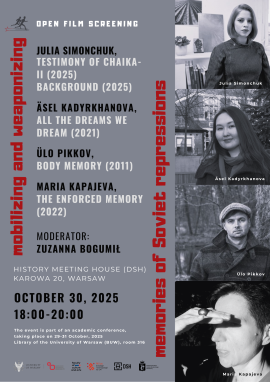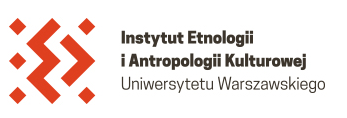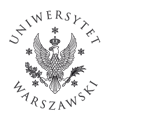Reading of Names: October 29, 2025 / Jan Twardowski Square
On the eve of the Day of Remembrance for the Victims of Political Repressions, the Memorial Organization continues the tradition of reading the names of the victims of political repression. This practice began in 2007 in Moscow where people would gather in front of the Solovetsky Stone — erected by Memorial in 1990, opposite the headquarters of the security services (formerly the NKVD, later the KGB, and now the FSB) - to read aloud the names of the victims along with their date of death or disappearance. This very simple and solemn act often took many hours, which alone served as a powerful reminder of the vast scale of the repression.
In 2022, for political reasons, the Memorial Organization was dissolved in Russia, but its work — including the practice of "reading the names" — is carried on by Memorial societies in other countries, including Poland. We encourage you to join this event organized by Memorial Poland and the History Meeting House, even if only for a moment. Reading the Names will take place between 18:00 and 20:00 at ks.Jan Twardowski Square, in the vicinity of the main campus of the University of Warsaw.
Film screening: October 30, 2025 / History Meeting House, Karowa 20 (Warsaw, Poland)
Julia Simonchuk
Julia-Anna Simonchuk grew up in Kyiv, Ukraine and has been a Londoner for six years now. She graduated from BA Fine Art course at CSM and is currently finishing a Fine Art MA at the Slade. She is working with sculpture, collage, installation, printmaking, socially-engaging projects and currently she is predominantly focusing on moving image. Among Julia’s thematic interests are questions of power, ideology, memorialisation, presence and absence, hauntology, social dancing and time.
Testimony of CHAIKA-II (2025)
In the short film ‘Testimony of Chaika-II’, the protagonist is an old photo camera, which is granted subjectivity and a voice. The camera is an artifact from a collection of Museum of Occupations and Freedom Fights in Vilnius, Lithuania (former KGB and Gestapo headquarters). Chaika-II is talking about what it saw but couldn’t capture and is reflecting on the uses of technology, nature of documentary photography, as well as agency and complicity.
Background (2025)
‘Backgrounds’ is aresponse to the Museum of Occupations and Freedom Fights (former KGB headquarters and detention centre) in Vilnius. This work is an attempt to address emotionally charged stories and histories through the language of the abstract.
The cells and corridors have typical institutional walls – divided into two colour sections. When encountered from up close, the area where one colour meets another can look like austere and deserted fields. The palimpsests of earth are preserving the evidence of violence and so are the layers of paint on the walls (repainted about 20 times to cover blood and inscriptions).
Äsel Kadyrkhanova
Äsel Kadyrkhanova is a visual artist and researcher, currently a postdoctoral fellow at the Amsterdam School for Cultural Analysis. Her artistic practice spans drawing, textile, video and animation. Her research interests include autoethnography, visual storytelling, affect and haptic visuality. Her work addresses postcolonial hauntings, the burdens of silenced histories and unmourned personal losses.
All the Dreams We Dream (2021)
All the Deams we Dream is a hand-drawn animation film that discusses the (non-) memory of the Kazakh famine, 1930 - 1933. Caused by the Soviet policies of collectivisation, the famine was an event of such extremity that it shattered the very foundations of Kazakh nomadic society, making it easier to Sovietise the region. Throughout the film, the focus remains on the subtle boundary between animal and human and between human and non-human. As it explores the relationship between image, sound and text, it aims to construct a counter-narrative or a space for resistance to the dominant ideological narratives of the Soviet cultural production it references.
Ülo Pikkov
Ülo Pikkov is an internationally renowned filmmaker, producer and film scholar. He is the manager and producer for documentary and animation films in Silmviburlane. He studied animation at the Turku Arts Academy in Finland and since 1996 has directed several award-winning animation films. He has published articles on film and written fiction books for children and adults. In 2005 he graduated from the Institute of Law in University of Tartu, focusing on the media and author’s rights.
Body Memory (2011)
Our bodies remember more that we can expect and imagine; our bodies also remember the sorrow and pain of our predecessors. Our bodies sustain the stories of our parents and grandparents as well as they ancestors. But how far back is it possible to go in body memory?
Maria Kapajeva
Maria Kapajeva is an artist who works between the UK and Estonia, while exhibiting her works internationally. Through her artistic practice, Kapajeva looks at the identity and gender questions of peoples being in-between or in-transition, often bringing peripheral stories to the visible centre. Kapajeva practice is multidisciplinary: she works with found and vernacular photographic images, video installations, textile and embroidery and participatory practices.
The enforced memory (2022)
The video is artist’s personal reaction on the events of August 2022, which took place in Estonia, in Narva, her home town. Since the war in Ukraine escalated, the removal of Soviet monuments in Estonia became intensively debated topic. The tank monument in Narva became a stumbling block between the views of different communities within the country. It has especially became symbolic and problematic because it stood right at the border with Russia, on a riverbank of Narva river, facing Estonia. This video is artist first attempt to express a personal take on the events and the war, happening at this moment in Ukraine.




